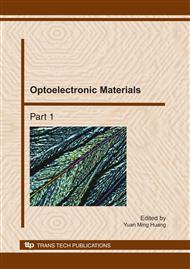p.340
p.344
p.348
p.352
p.356
p.361
p.365
p.369
p.373
Effect of Ammoniating Temperature on Growth of GaN Nanowires with V as Intermediate Layer
Abstract:
GaN nanowires have been successfully grown on Si (111) substrates by magnetron sputtering through ammoniating Ga2O3/V thin films. The influence of ammoniating temperature on the growth of GaN nanowires was analyzed in particular. The results demonstrate that ammoniating temperature has great influence on the growth of GaN nanowires. GaN nanowires are single crystal GaN with a hexagonal wurtzite structure and high crystalline quality after ammoniation at 900 oC for 15 min, which are straight and smooth with uniform thickness along the spindle direction and high crystalline quality, 50 nm in diameter and several tens of microns in length with good emission properties, and the growth direction of the nanowire is along the preferred (002) plane. A clear red-shift of the band-gap emission has occurred. The growth mechanism is also discussed briefly.
Info:
Periodical:
Pages:
356-360
Citation:
Online since:
November 2010
Authors:
Price:
Сopyright:
© 2011 Trans Tech Publications Ltd. All Rights Reserved
Share:
Citation:


